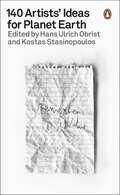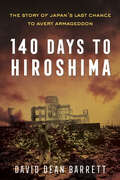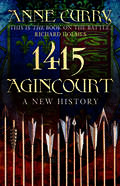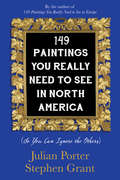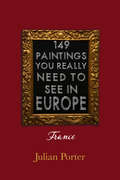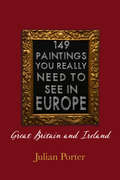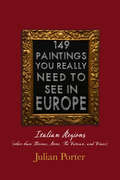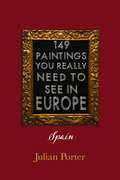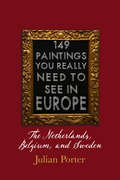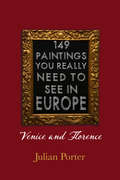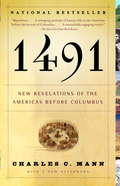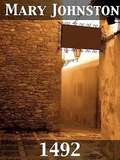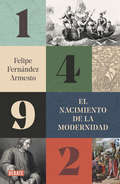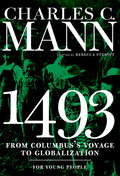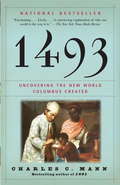- Table View
- List View
140 Artists' Ideas for Planet Earth
by Hans Ulrich Obrist Kostas StasinopoulosThrough 140 drawings, thought experiments, recipes, activist instructions, gardening ideas, insurgences and personal revolutions, artists who spend their lives thinking outside the box guide you to a new worldview; where you and the planet are one.Everything here is new. We invite you to rip out pages, to hang them up at home, to draw and scribble, to cook, to meditate, to take the book to your nearest green space.Featuring Olafur Eliasson, Etel Adnan, Alexis Pauline Gumbs, Jane Fonda & Swoon, Judy Chicago, Black Quantum Futurism Collective, Vivienne Westwood, Cauleen Smith, Marina Abramovic, Karrabing Film Collective, and many more.
140 Days to Hiroshima: The Story of Japan's Last Chance to Avert Armageddon
by David Dean BarrettA WWII history told from US and Japanese perspectives—&“an impressively researched chronicle of the months leading up to the atomic bombing of Hiroshima&” (Publishers Weekly). During the closing months of World War II, two military giants locked in a death embrace of cultural differences and diplomatic intransigence. While developing history&’s deadliest weapon and weighing an invasion that would have dwarfed D-Day, the US called for the &“unconditional surrender&” of Japan. The Japanese Empire responded with a last-ditch plan termed Ketsu-Go, which called for the suicidal resistance of every able-bodied man and woman in &“The Decisive Battle&” for the homeland. In 140 Days to Hiroshima, historian David Dean Barrett captures war-room drama on both sides of the conflict. Here are the secret strategy sessions, fierce debates, looming assassinations, and planned invasions that resulted in Armageddon on August 6, 1945. Barrett then examines the next nine chaotic days as the Japanese government struggled to respond to the reality of nuclear war.
1415 Agincourt: A New History
by Anne CurryFor many commentators then and now, it was the English archers who won the day for Henry V. This lavishly illustrated history re-tells the story of the battle and Henry V's Normandy campaign from the perspective of the commander of the English archers, Sir Thomas Erpingham. Sir Thomas, an experienced warrior with military experience dating back 40 years is known for his brief but pivotal appearances in Shakespeare's Henry V, where he is correctly portrayed as an elderly, white haired veteran. At 57 he was one of the oldest there and a close personal confident of the King. But what was his background? How did he command his archers to such a place in history? And what role did the longbow and battlefield tactics play in the final analysis of victory?
1421: The Year China Discovered America
by Gavin MenziesOn March 8, 1421, the world's largest fleet set sail from China. When the fleet returned home in October 1423, the emperor had fallen, leaving China in political and economic chaos. The great ships were left to rot at their moorings and the records of their journeys were destroyed. Lost in the long, self-imposed isolation that followed was the knowledge that Chinese ships had reached America seventy years before Columbus and had circumnavigated the globe a century before Magellan.
1434: The Year a Magnificent Chinese Fleet Sailed to Italy and Ignited the Renaissance
by Gavin MenziesThe New York Times bestselling author of 1421 offers another stunning reappraisal of history, presenting compelling new evidence that traces the roots of the European Renaissance to Chinese exploration in the fifteenth centuryThe brilliance of the Renaissance laid the foundation of the modern world. Textbooks tell us that it came about as a result of a rediscovery of the ideas and ideals of classical Greece and Rome. But now bestselling historian Gavin Menzies makes the startling argument that in the year 1434, China—then the world's most technologically advanced civilization—provided the spark that set the European Renaissance ablaze. From that date onward, Europeans embraced Chinese intellectual ideas, discoveries, and inventions, all of which form the basis of western civilization today.Florence and Venice of the early fifteenth century were hubs of world trade, attracting traders from across the globe. Based on years of research, this marvelous history argues that a Chinese fleet—official ambassadors of the emperor—arrived in Tuscany in 1434, where they were received by Pope Eugenius IV in Florence. The delegation presented the influential pope with a wealth of Chinese learning from a diverse range of fields: art, geography (including world maps that were passed on to Christopher Columbus and Ferdinand Magellan), astronomy, mathematics, printing, architecture, steel manufacturing, military weaponry, and more. This vast treasure trove of knowledge spread across Europe, igniting the legendary inventiveness of the Renaissance, including the work of such geniuses as da Vinci, Copernicus, Galileo, and more.In 1434, Gavin Menzies combines this long-overdue historical reexamination with the excitement of an investigative adventure. He brings the reader aboard the remarkable Chinese fleet as it sails from China to Cairo and Florence, and then back across the world. Erudite and brilliantly reasoned, 1434 will change the way we see ourselves, our history, and our world.
1453: The Holy War for Constantinople and the Clash of Islam and the West
by Roger CrowleyA gripping exploration of the fall of Constantinople and its connection to the world we live in today.The fall of Constantinople in 1453 signaled a shift in history and the end of the Byzantium Empire. Roger Crowley's readable and comprehensive account of the battle between Mehmet II, sultan of the Ottoman Empire, and Constantine XI, the 57th emperor of Byzantium, illuminates the period in history that was a precursor to the current conflict between the West and the Middle East.
148 Charles Street: A Novel
by Tracy DaughertyTracy Daugherty&’s historical novel 148 Charles Street explores the fascinating story of Willa Cather&’s friendship with Elizabeth Shepley Sergeant. The women shared a passion for writing, for New York, and for the desert Southwest, but their sensibilities could not have been more different: Cather, the novelist of lyrical landscapes and aesthetic refinement, and Sergeant, the muckraking journalist and literary activist. Their friendship is sorely tested when Cather fictionalizes a war that Sergeant covered as a reporter, calling into question, for both women, the uses of art and journalism, the power of imagination and witness. 148 Charles Street is a testament to the bonds that endure despite disagreements and misunderstandings, and in the relentlessness of a vanishing past.148 Charles Street explores, as only fiction can, the two writers&’ interior lives, and contrasts Sergeant&’s literary activism with Cather&’s more purely aesthetic approach to writing.
149 Paintings You Really Need to See in Europe: (So You Can Ignore the Others)
by Julian PorterVisit some of Europe’s greatest museums and galleries in the company of a knowledgeable tour guide. "Who can resist an art critic with attitude?" – Former Supreme Court of Canada Justice, Ian Binnie "It was wonderful! Julian shared his enormous knowledge of the world’s best art with a panache that is irresistible." – Justice Stephen Goudge, Ontario Court of Appeal This essential companion to all the major European museums and galleries discusses some of the world’s greatest paintings from Giotto through to Picasso. Julian Porter’s passion for art began with the seven years he spent as a student tour guide in Europe. Since then, he has conducted countless tours of Europe’s famous galleries – The Louvre, The Prado, The Hermitage, The Rijksmuseum, the Sistine Chapel, and many others. In the usually pretentious arena of art connoisseurs, Porter’s voice stands out as fresh and original. He finds the best of the best, which he describes with entertaining irreverence, and spares you hours of sore feet and superfluous information.
149 Paintings You Really Need to See in North America: (So You Can Ignore the Others)
by Julian Porter Stephen GrantTour North America’s greatest museums and galleries in the company of two incomparable guides. This lively companion highlights the essential paintings, by some of the world’s greatest painters, from Giotto to Picasso, on display in North American museums and galleries. Julian Porter has had a life-long passion for art. He worked for seven years as a student tour guide in Europe and since has conducted countless gallery tours in Europe and North America. His co-author, Stephen Grant, brings a wealth of expertise in twentieth-century artists, and presents them within the framework of a North American–led, sustained burst of originality and shock. Presented with wit and irreverence, here is the best that North American galleries have to offer. Focused and curated to give you everything you need to enjoy the greatest works of art in the best company and save you the sore feet and superfluous information.
149 Paintings You Really Should See in Europe — France
by Julian PorterThis chapter from Julian Porter’s essential companion to all the major European museums and galleries discusses some of the greatest paintings to be found in the museums and galleries of France. His passion for art began with the seven years he spent as a student tour guide in Europe. In this segment he visits Paris and discusses works by masters such as Delacroix, David, Renoir, Manet, Degas, and many more. In the usually pretentious arena of art connoisseurs, Porter’s voice stands out as fresh and original. He finds the best of the best, which he describes with entertaining irreverence, and spares you hours of sore feet and superfluous information.
149 Paintings You Really Should See in Europe — Germany and Austria
by Julian PorterThis chapter from Julian Porter’s essential companion to all the major European museums and galleries discusses some of the greatest paintings to be found in the museums and galleries of Germany and Austria. His passion for art began with the seven years he spent as a student tour guide in Europe. In this segment he visits Berlin, Vienna, Dresden, and Munich and discusses works by masters such as Rembrandt, Watteau, Raphael, Van Eyck, Dürer, and many more. In the usually pretentious arena of art connoisseurs, Porter’s voice stands out as fresh and original. He finds the best of the best, which he describes with entertaining irreverence, and spares you hours of sore feet and superfluous information.
149 Paintings You Really Should See in Europe — Great Britain and Ireland
by Julian PorterThis chapter from Julian Porter’s essential companion to all the major European museums and galleries discusses some of the greatest paintings to be found in the museums and galleries of the United Kingdom and Ireland. His passion for art began with the seven years he spent as a student tour guide in Europe. In this segment he visits London, Dublin, and the university towns of Cambridge and Oxford and discusses works by masters such as Constable, Turner, Waterhouse and many more. In the usually pretentious arena of art connoisseurs, Porter’s voice stands out as fresh and original. He finds the best of the best, which he describes with entertaining irreverence, and spares you hours of sore feet and superfluous information.
149 Paintings You Really Should See in Europe — Italian Regions (other than Florence, Rome, The Vatican, and Venice)
by Julian PorterThis chapter from Julian Porter’s essential companion to all the major European museums and galleries discusses some of the greatest paintings to be found in the museums and galleries of Italy. His passion for art began with the seven years he spent as a student tour guide in Europe. In this segment he visits Milan, Arezzo, Parma, Mantua, Assisi, Naples, Orvieto, and Padua and discusses works by masters such as Titian, Tintoretto, Bellini, Giotto, and many more. In the usually pretentious arena of art connoisseurs, Porter’s voice stands out as fresh and original. He finds the best of the best, which he describes with entertaining irreverence, and spares you hours of sore feet and superfluous information.
149 Paintings You Really Should See in Europe — Rome and Vatican City
by Julian PorterThis chapter from Julian Porter’s essential companion to all the major European museums and galleries discusses some of the greatest paintings to be found in the museums and galleries of Rome and the Vatican, including the Sistine Chapel. His passion for art began with the seven years he spent as a student tour guide in Europe. In this segment he discusses works by masters such as Michelangelo, Caravaggio, and Raphael. In the usually pretentious arena of art connoisseurs, Porter’s voice stands out as fresh and original. He finds the best of the best, which he describes with entertaining irreverence, and spares you hours of sore feet and superfluous information.
149 Paintings You Really Should See in Europe — Russia, Poland, and the Czech Republic
by Julian PorterThis chapter from Julian Porter’s essential companion to all the major European museums and galleries discusses some of the greatest paintings to be found in the museums and galleries of Russia, Poland, and the Czech Republic. His passion for art began with the seven years he spent as a student tour guide in Europe. In this segment he visits St. Petersburg, Krakow, and Prague and discusses works by masters such as da Vinci, Matisse, Dürer, and many more. In the usually pretentious arena of art connoisseurs, Porter’s voice stands out as fresh and original. He finds the best of the best, which he describes with entertaining irreverence, and spares you hours of sore feet and superfluous information.
149 Paintings You Really Should See in Europe — Spain
by Julian PorterThis chapter from Julian Porter’s essential companion to all the major European museums and galleries discusses some of the greatest paintings to be found in the museums and galleries of Spain. His passion for art began with the seven years he spent as a student tour guide in Europe. In this segment he visits Madrid and Toledo and discusses works by masters such as Goya, Bosch, Velázquez, Picasso, El Greco, and many more. In the usually pretentious arena of art connoisseurs, Porter’s voice stands out as fresh and original. He finds the best of the best, which he describes with entertaining irreverence, and spares you hours of sore feet and superfluous information.
149 Paintings You Really Should See in Europe — The Netherlands, Belgium, and Sweden
by Julian PorterThis chapter from Julian Porter’s essential companion to all the major European museums and galleries discusses some of the greatest paintings to be found in the museums and galleries of The Netherlands, Belgium, and Sweden. His passion for art began with the seven years he spent as a student tour guide in Europe. In this segment he visits Amsterdam, Stockholm, The Hague, Bruges, Antwerp and Ghent and discusses works by the Dutch masters such as Vermeer, Rembrandt, and Van Eyck, but also Van Gogh and Renoir. In the usually pretentious arena of art connoisseurs, Porter’s voice stands out as fresh and original. He finds the best of the best, which he describes with entertaining irreverence, and spares you hours of sore feet and superfluous information.
149 Paintings You Really Should See in Europe — Venice and Florence
by Julian PorterThis chapter from Julian Porter’s essential companion to all the major European museums and galleries discusses some of the greatest paintings to be found in the museums and galleries of Florence and Venice. His passion for art began with the seven years he spent as a student tour guide in Europe. In this segment he discusses works by masters such as Tintoretto, Botticelli, Veronese, and many more. In the usually pretentious arena of art connoisseurs, Porter’s voice stands out as fresh and original. He finds the best of the best, which he describes with entertaining irreverence, and spares you hours of sore feet and superfluous information.
1491: The Americas Before Columbus
by Charles MannIn this groundbreaking work of science, history, and archaeology, Charles C. Mann radically alters our understanding of the Americas before the arrival of Columbus in 1492. Contrary to what so many Americans learn in school, the pre-Columbian Indians were not sparsely settled in a pristine wilderness; rather, there were huge numbers of Indians who actively molded and influenced the land around them. The astonishing Aztec capital of Tenochtitlan had running water and immaculately clean streets, and was larger than any contemporary European city. Mexican cultures created corn in a specialized breeding process that it has been called man's first feat of genetic engineering. Indeed, Indians were not living lightly on the land but were landscaping and manipulating their world in ways that we are only now beginning to understand. Challenging and surprising, this is a transformative new look at a rich and fascinating world we only thought we knew.
1492
by Mary JohnstonIn the 15th century, a fabulous journey awaited those who could unlock the secrets of the Earth's geography. Beautifully written and emotionally compelling, 1492: Admiral of the Ocean-Sea tells of the famous adventures of Columbus and his men, who sailed into the almost mythical seas beyond the horizon in search of the "New World," in the hopes of attaining vast wealth and power. <P> <P> This brilliant book, by best-selling author Mary Johnston, traces the long route taken by explorers hoping to locate Asia. Based on their limited means and understanding of navigation, they struggle to find their position, while at the same time encountering many natural wonders and exotic peoples. Tensions build as they appear to become increasingly lost. Columbus and his crew begin to lose hope, until they finally receive the vindication of their bold vision. 1492: Admiral of the Ocean-Sea pays special attention to the conditions of the late 15th century period. It describes the competition between classes and ethnic groups in Spain, as well as the clashes that occurred when people from two very different cultures, native American and European, interact. These issues are not merely abstract, since we see them vividly through the eyes of a disenfranchised individual: a Christian sailor of Jewish background, who has been compelled to lead a secretive and solitary existence. The incidents of his life are brought to us in a handsome, elegant language, uncommon in the books of our day.
1492
by Newton Frohlich Ramón Hervás1492 pone en escena a los grandes protagonistas de al epopeya del descubrimiento de América: Cristóbal Colón, la reina Isabel de Castilla, el rey Fernando de Aragón.
1492: El nacimiento de la modernidad
by Felipe Fernández-ArmestoGuerras, brujería, plagas y persecuciones, ciencia, magia y profecías, arte y fe, las glorias y miserias de 1492 nos hablan de un mundo en movimiento en este relato deslumbrante que constituye una auténtica historia global del nacimiento de la modernidad. Profetas, adivinos y astrólogos auguraron que el mundo terminaría en 1492. Tenían razón. Su mundo acabó y empezó el nuestro. Este fascinante viaje de la Edad Media a la modernidad nos explica los acontecimientos que hicieron posible el mundo en que vivimos: el aumento de los intercambios comerciales y sus efectos en la economía mundial, la forma en que las principales civilizaciones y religiones dividieron el mundo o el cambio en la distribución de la riqueza. De la mano de un guía extraordinario como Felipe Fernández-Armesto, y en compañía de los viajeros auténticos que hicieron posible la transformación, asistimos en Granada, Pekín, Estambul o Tombuctú, y a personajes comoIván el Terrible, Alejandro Borgia, Colón o Zheng He, que protagonizaron este momento de transición.
1492: The Year the Four Corners of the Earth Collided
by Felipe Fernandez-ArmestoA study of events of 1492 and how they affect the global community of the world of today.The world would end in 1492—so the prophets, soothsayers and stargazers said. They were right. Their world did end. But ours began.In search of the origins of the modern world, 1492 takes readers on a journey around the globe of the time, in the company of real-life travellers, drawing together the threads that began to bind the planet: from the way power and wealth are distributed around the globe to the way major religions and civilizations divide the world. Events that began in 1492 even transformed the whole ecological system of the planet. Wars and witchcraft, plagues and persecutions, poetry and prophecy, science and magic, art and faith—all the glories and follies of the time are in this book.
1493 for Young People
by Rebecca Stefoff Charles Mann1493 for Young People by Charles C. Mann tells the gripping story of globalization through travel, trade, colonization, and migration from its beginnings in the fifteenth century to the present. How did the lowly potato plant feed the poor across Europe and then cause the deaths of millions? How did the rubber plant enable industrialization? What is the connection between malaria, slavery, and the outcome of the American Revolution? How did the fabled silver mountain of sixteenth-century Bolivia fund economic development in the flood-prone plains of rural China and the wars of the Spanish Empire? Here is the story of how sometimes the greatest leaps also posed the greatest threats to human advancement.Mann's language is as plainspoken and clear as it is provocative, his research and erudition vast, his conclusions ones that will stimulate the critical thinking of young people. 1493 for Young People provides tools for wrestling with the most pressing issues of today, and will empower young people as they struggle with a changing world.From the Hardcover edition.
1493: Uncovering the New World Columbus Created
by Charles MannFrom the author of1491—the best-selling study of the pre-Columbian Americas—a deeply engaging new history of the most momentous biological event since the death of the dinosaurs. More than 200 million years ago, geological forces split apart the continents. Isolated from each other, the two halves of the world developed radically different suites of plants and animals. When Christopher Columbus set foot in the Americas, he ended that separation at a stroke. Driven by the economic goal of establishing trade with China, he accidentally set off an ecological convulsion as European vessels carried thousands of species to new homes across the oceans. The Columbian Exchange, as researchers call it, is the reason there are tomatoes in Italy, oranges in Florida, chocolates in Switzerland, and chili peppers in Thailand. More important, creatures the colonists knew nothing about hitched along for the ride. Earthworms, mosquitoes, and cockroaches; honeybees, dandelions, and African grasses; bacteria, fungi, and viruses; rats of every description—all of them rushed like eager tourists into lands that had never seen their like before, changing lives and landscapes across the planet. Eight decades after Columbus, a Spaniard named Legazpi succeeded where Columbus had failed. He sailed west to establish continual trade with China, then the richest, most powerful country in the world. In Manila, a city Legazpi founded, silver from the Americas, mined by African and Indian slaves, was sold to Asians in return for silk for Europeans. It was the first time that goods and people from every corner of the globe were connected in a single worldwide exchange. Much as Columbus created a new world biologically, Legazpi and the Spanish empire he served created a new world economically. As Charles C. Mann shows, the Columbian Exchange underlies much of subsequent human history. Presenting the latest research by ecologists, anthropologists, archaeologists, and historians, Mann shows how the creation of this worldwide network of ecological and economic exchange fostered the rise of Europe, devastated imperial China, convulsed Africa, and for two centuries made Mexico City—where Asia, Europe, and the new frontier of the Americas dynamically interacted—the center of the world. In such encounters, he uncovers the germ of today’s fiercest political disputes, from immigration to trade policy to culture wars. In1493,Charles Mann gives us an eye-opening scientific interpretation of our past, unequaled in its authority and fascination.
